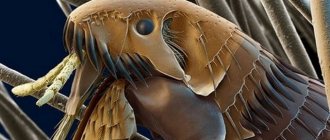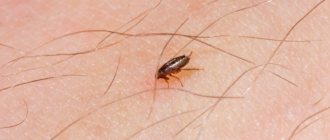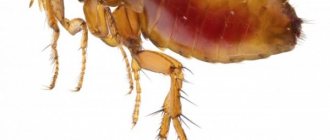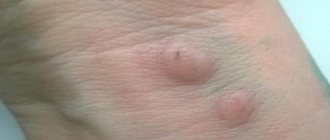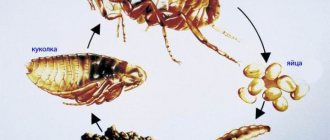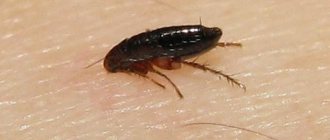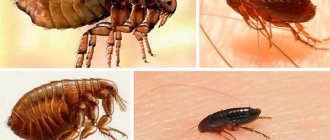- Man, take the dog away! There are already fleas running all over me!
- Tuzik, move away from your aunt, she has fleas.
This viciously sarcastic anecdote illustrates how widespread the misconception is that dogs can give you fleas. A tuzik that has a host cannot infect anyone with ectoparasites. He himself does not have many of them, and they do not express a desire to move to another carrier. Fleas are transmitted from a dog to humans only in one case: the dog is sick and weakened, and the population of fleas on its body has exceeded all conceivable limits. But shelter volunteers are more likely to encounter such dogs than ordinary citizens.
Are fleas transmitted from dogs to humans?
Fans wonder: can fleas pass from a dog to a person? Yes, this is a serious issue that needs to be looked at carefully. These are dangerous blood-sucking insects that can introduce infection into the body.
Stroking the dog once is safe; during it, insects will not be able to jump onto the surface of the body. This will not save you from germs, so you need to wash your hands with soap. And if a dog starts to itch after a walk outside, this may be a signal that it has parasites.
The owner should take into account that furry dog breeds may have more fleas:
- Affenpinscher;
- Alaskan Malamute;
- Border Collie;
- Irish Wolfhound;
- Pekingese;
- Pomeranian Spitz;
- Samoyed dog;
- Tibetan mastiff;
- Chow-chow;
- Sheltie;
- Shih Tzu;
- Japanese Spitz;
- Scottish Collie.
It is advisable to immediately begin removing bloodsuckers. If you start it, then after a short period of time there will be a lot of parasites, they will begin to spread and bite your legs. With severe hunger, other parts of the body are attacked - arms, back, stomach, face.
The food is the blood of animals.
They live and hide in the fur of dogs. And the hair on people’s bodies will not allow bloodsuckers to settle in and lay eggs. This means that insects cannot settle on the body.
Are fleas transmitted from dogs to humans? Insects attack people when they feel hungry. The main habitats are the bedding of dogs, cats, garbage, where there is an increased likelihood of being bitten.
general characteristics
Fleas are classified as obligate and ectoparasites (that live on the body of their host) that feed exclusively on blood. The usual habitat of these insects is the fur of warm-blooded animals (for example, dogs, cats, birds and others).
It happens that these parasites choose a person to satisfy hunger or transport. Most often, it turns out to be a temporary host, since the human body is of little use for their life:
- does not have a rich coat of hair,
- low body temperature (lower than in animals),
- compliance with hygiene standards.
There are an incredible number of these ectoparasites (about 2000), but the most common types are the following:
How quickly fleas multiply in an apartment and in cats All about earthen fleas and the fight against them Rat fleas in an apartment and how to get rid of them Elk fleas: description, danger to humans, protection from parasites
- Living on pets and other animals, birds.
- Earth (or human).
- Bedding (found in pillows and mattresses).
- Sandy.
Parasites of animals and birds
The bites of rat fleas pose a great danger to humans, since they are the causative agents of serious diseases (plague, typhoid, etc.). Dog parasites are almost indistinguishable from and carry the same diseases.
are carriers of many infectious diseases and fungal viruses, as well as various helminths (for example, flatworms, roundworms, echinococci). Cat parasites are the most common.
Infection with ectoparasites is also typical for birds. So, you need to be careful not only in places where they accumulate (nests, chicken coop, pigeon coop, etc.), but also on city streets. The pigeon parasite is most often found not only in domestic birds, but also in stray birds.
NOTE! To quickly get rid of fleas and lice, there are only three effective options:
- Calling a pest control service (expensive),
- Purchase (1390 rubles),
- Chemicals (doubtful effect).
Read more here...,
Therefore, do not contact them (especially sickly-looking individuals), because they are carriers of diseases (for example, salmonellosis).
Sand fleas. These parasites are small in size. They are most often found in the tropical and equatorial zones and live in the sands near the sea. Their activity increases at dawn and dusk. It is worth noting: the danger of sand parasites is that when they bite, they lay larvae that come out and live in the floor.
Human flea
The ectoparasite of this species is characterized by the following:
- Quite large sizes.
- Dark brown color.
- The female is capable of laying about 8 eggs at a time.
- The life cycle lasts about a year.
- Movement occurs by jumping.
- Carries some parasitic flatworms and worms.
- The causative agent of various diseases.
During World War II, the Japanese used fleas as a biological weapon, killing about half a million people.
Do dog fleas bite people?
It's safe to say that dog fleas bite people. And they do this often, especially if there are a lot of them, or when the pet is not at home, but its bedding and things are left behind. Insects can attack when hungry.
The parasite's mouthparts are designed to feed on blood. Insects have an excellent sense of smell; prey is identified using carbon dioxide during breathing. As soon as the bloodsucker reaches the surface of the body, it bites into the skin and begins to suck blood.
Fleas bite the surface of the legs, and when there are many bloodsuckers, they infect the body. They will inflict bites, which after a certain period begin to itch. When scratching, red spots appear on the surface of the body. And if you get an infection, the wounds will tear and rot. It is better to treat the affected area with an antiseptic and do not touch it.
On what parts of the body do insects bite?
Fleas jump to a height of 15 cm, so they bite the lower areas of the human body: feet, legs, ankles. In a sitting position – wrist, pelvic area. In children, due to their small stature, they can bite their face and neck.
At the site of the bite, a swelling appears with traces of blood, a papule similar to a HIV infection. More often, fleas bite the legs and lower limbs, with bites located at a distance of 20 cm from each other. Main features:
- itching;
- increase in local temperature;
- deterioration of health;
- pain at the time of injection of saliva;
- rash, swelling of soft tissues;
- enlarged lymph nodes.
Are dog fleas dangerous for people?
Are dog fleas dangerous for humans?
We can answer in the affirmative; blood-sucking parasites pose a high danger to people. Bloodsuckers can cause an infection that can be fatal.
Why are dog flea bites dangerous?
As we found out, fleas can bite pets and people. You should be prepared that along with the bite you can get an infection that can cause health problems.
Why flea bites are dangerous for people:
- allergy. People are often allergic to saliva. During it, redness, swelling, itching are observed, and papules are formed. Rarely, bites cause eczema or psoriasis;
- infection. As soon as the parasites bite, the person begins to itch until wounds form. They become infected. It is identified by signs - severe redness, pain, inflammation and discharge of pus.
What diseases do parasites carry?
Dog owners should know what diseases are transmitted by flea bites, because they pose a danger to life. Almost all bloodsuckers carry dangerous infectious diseases.
Just look at the list:
- helminthiasis The disease manifests itself upon contact with an insect: if you crush it and do not wash your hands, you can spread the infection with food. You get worms. Bloodsuckers carry tapeworms, roundworms, flukes and others;
- brucellosis. During infection, sweating occurs, body temperature rises, and joint pain is observed. Then almost all systems in the body are affected. If you do not begin to treat the disease, it leads to disability;
- tularemia. This is a bacterial disease during which there is increased inflammation of the lymph nodes. Fever and signs of poisoning are noted;
- salmonellosis. Parasites cause a serious intestinal infection. Manifestations include foul-smelling, foamy stools, abdominal pain, bloating, fever;
- typhus When infected with the disease, a fever appears, and a rash with a spotty and pink structure forms on the surface of the body.
Prevention of bites
Knowing whether animal fleas can bite people, every pet breeder takes preventive measures:
- check your pets regularly;
- processing is carried out if necessary;
- Wear a flea collar when walking.
Considering why animal fleas bite humans, protective equipment is used for any possible contact with blood-sucking fleas. It is enough to wear closed clothing and use repellents. Animals that often walk outside should not be allowed into the bed or on upholstered furniture. Small children should not be allowed to crawl on the floor.
Plants with a strong smell - wormwood, mint, thistle - also help fight them. To prevent parasites from biting, several branches of plants are placed at the thresholds of the rooms. Essential oils are effective against insects. A few drops of tea tree oil, mint, and geranium added to the water for washing the floor will prevent insects from entering the apartment.
dog examination
Methods for controlling dog fleas
Fleas are unpleasant parasites for animals and people, so it is worth fighting them after they are found on a dog. While there are only a few of them, they won’t bite or cause harm, but don’t forget that insects multiply quickly, so don’t hesitate to remove them.
If you find bloodsuckers in a dog, you need to disinfect the room.
To do this, you will need to make a solution of baking soda, salt, and insecticidal shampoo. It is worth using an insecticide - aerosol, powder or solution.
When processing, you should follow the following steps:
- vacuum the apartment, furniture, carpets;
- things should be washed or dry-cleaned, especially those that may harbor insects;
- dog bedding should be treated, or better yet, thrown away;
- Pet household items need to be treated;
- carry out wet cleaning in the house. To do this, you need to use a solution - a pack of salt or soda per 10 liters of water;
- When processing, close the windows, move the furniture, wash hard-to-reach places - baseboards, cracks, corners, window sills, furniture walls, carpets and other surfaces;
- pour or spray insecticide in the apartment;
- leave the room for several hours, during which time the parasites should die;
- after treatment, the apartment must be ventilated and cleaned;
- After 7-10 days it is worth repeating the treatment.
How to prevent fleas from appearing in the house
Everyone should remember the danger insects pose, and they should make efforts to prevent their appearance. Parasites can lead to infectious diseases, many of which can be life-threatening.
Typically found on dogs, it is important to treat animals promptly.
To do this, you can use insecticidal shampoos, sprays, and an anti-flea collar for dogs:
- Phytoelite. A drug based on herbs. The active substance is permethrin. Causes increased destruction of bloodsuckers;
- Doctor ZOO. It is a natural product containing essential oils. It can be used for puppies from 2 months of age;
- Bars (AVZ). Good product for bathing. The active effect of the shampoo is associated with the essential oils that are present in the composition;
- Bruno is a therapeutic and prophylactic drug against ectoparasites;
- Imported shampoo with natural oils. Can be used for puppies older than 2 months;
- Drops with complex action from an American manufacturer. Contains selamectin;
- BlochNet Max. A line of domestic insecticidal drops with repellent, barrier and destructive effects;
- Anti-flea collar. It is based on propoxur and flumethrin;
- Rolf Club 3D. A collar with a combined effect. Contains pyriproxyfen, fipronil, D-pyphenothrine.
Don't forget about cleaning the room. It is imperative to treat the surfaces with special products once a week and wash the surfaces with a solution of salt and soda. This will reduce the likelihood of parasites.
How to detect the presence of fleas in the house?
If you begin to notice itching on your legs, especially at night, then there is a high probability of fleas in your apartment. Detecting them is quite difficult, but there is a special detection method:
- determine which room the fleas have settled in;
- lay several sheets of white paper or a white sheet on the floor;
- leave the room for a few minutes, then check the white canvas - if black dots appear on it, which disappear when approached, these are fleas.
Answers to popular questions
Fleas are often found in dogs, but, as mentioned above, they can sometimes attack people.
For this reason, many may have some questions about this, and knowing the answers to them can help identify parasites and prevent unpleasant consequences.
What are the signs of fleas in humans?
Fleas cannot live on humans, but they can bite.
In this case, signs are found on the body:
- redness;
- rashes;
- feeling of itching;
- Over time, the bite site may begin to itch very much;
- Strong scratching creates a wound that can become infected.
What do dog fleas look like?
Bloodsuckers have the following characteristics:
- They are small in size, body length is only 2-4 mm;
- their chitinous cover has many bristles that firmly hold the insect on the surface;
- they jump high and far. Insects jump over a distance that is three times their visibility zone – 18 cm;
- The oral apparatus is perfectly adapted to the skin of dogs, but if there is a lack of food, fleas can live on people and cats.
Fleas are dangerous parasites that harm animals and people. You shouldn’t think that they don’t attack, because when there is a lack of food, parasites bite people’s bodies.
And their bite is dangerous because it causes discomfort, itching and redness, and infectious diseases are transmitted with saliva, which can be fatal. For this reason, you need to know the signs of their appearance and measures to combat them.
What types of fleas are there?
A flea is a dangerous parasite that feeds on the blood of higher (warm-blooded) animals, mainly birds and mammals, incl. person.
The flea's mouthparts are designed in such a way that the insect cannot obtain any other type of food, in other words, the parasite is a real vampire.
Important! The flea's Latin name, Siphonaptera, is derived from two ancient Greek words: "σίφων", pump, and "ἄπτερον", devoid of wings.
It is characteristic that flea larvae (and the insect in question has a full cycle of transformation, i.e. it goes through all stages of development - egg, larva, pupa and adult), not having the necessary “tools” for independently sucking blood from the donor’s body, receive the entire required complex nutrients from the same blood, but already processed by the body of an adult individual and thrown out by it in a partially undigested form through feces.
The flea is distinguished by amazing endurance, fertility and vitality. Suffice it to say that the lifespan of the parasite can reach one and a half years (which is an impressive period for an insect), while each female is capable of giving birth to up to 500 or more similar individuals. Even more surprising is the fact that fleas are one of the few species of insects that live literally everywhere, inhabiting even such uninhabitable areas as Antarctica (the body of Antarctic birds, however, is parasitized by only one species of flea - Glaciopsyllus antarcticus, and These insects are not found anywhere else in the world).
It is not surprising that, having such a wide distribution area, the flea over the period of evolution had to adapt to a specific climatic environment and nutritional conditions - animal species that can be used as a donor.
Did you know? Golden beetles have the longest life expectancy among insects - up to 50 years. Bagworm butterflies live the shortest of all - having hatched from the larva, the imago dies within 5 minutes, having managed to mate and lay eggs during this time.
Indeed, the world of fleas is rich and diverse. Scientists know 2086 different species of these insects, however, 4 of them are considered extinct today. For a more detailed systematization, insects are usually divided into several families (according to different scientific versions, from 15 to 22), while the main enemies of people and domestic animals are concentrated in the Pulicidae family - the common flea.
Fleas, contrary to popular belief, do not tend to settle on the body of one owner. These parasites do not need frequent meals; moreover, having drunk plenty of blood, with a reserve, they can go without food for a very long time - sometimes up to several months. At the same time, the insect not only retains its viability, but even remains quite active, and the only precaution that the flea takes during the period of forced starvation is a temporary cessation of the reproduction process. Therefore, most fleas, having had their fill (the procedure of sucking blood by insects can last several hours), jump off the donor’s body, but try not to “lose sight of him,” remaining to live in the litter of the nest or other shelter where the “source of food” lives. It is in connection with this feature of the parasite that those animals that do not associate their lifestyle with a permanent home, but are actively on the move, suffer less from fleas than their more “homey” counterparts.
Nevertheless, stationary parasites are also found among fleas; these are the types of insects that attack marsupials and artiodactyls and, as a rule, have a more frequent need for food.
Important! Depending on the chosen donor, fleas can feed both on the ground and underground (in burrows) or above the ground (in bird nests, tree hollows).
Despite the ubiquity of the order, most representatives of Siphonaptera live in Europe, Asia, and North Africa, preferring temperate and subtropical climates to more extreme environmental conditions. Among the huge variety of parasites, only a few species cause the most problems, both economic and purely medical, to humans, namely:
| Insect type | Distinctive features | Who can it parasitize on? |
| Pulex irritans (human) | A fairly large insect, up to 3.2 mm in size, with very high jumping ability. Lives everywhere, is distinguished by the absence of teeth on the chest and head, the blood-sucking period lasts no more than 20 minutes, the process of digesting food lasts up to 5 hours | people, cats, dogs, horses, pigs, rodents, other domestic animals that have constant contact with people, as well as birds and wild animals - both predatory (wolves, foxes, ferrets, jackals, karsaks, large cats kept in captivity), and and herbivores (hares, marmots, monkeys, bulldog bats) |
| Ctenocephalides felis (feline) | A ubiquitous insect with a flat forehead and a short proboscis, body dimensions up to 5 mm. Has a very long life expectancy - up to 3 years | cats, dogs, rodents, many other animals, people |
| Ctenocephalides canis (canine) | Very similar to Ctenocephalides felis - both in size and in taste preferences, but does not live so long - up to 1.5 years | dogs, cats, wild animals, people |
| Xenopsylla cheopis (southern ratfish) | One of the most dangerous species. It has smaller dimensions than those described above, no more than 2–2.7 mm. Can be found everywhere, but mainly lives in warm countries | rats, gerbil mice, people |
| Vermipsylla alakurt (Tien Shan) | It is distinguished by its attachment to a narrow habitat (the Tien Shan mountain system) and is active exclusively in winter, moving onto farm animals during grazing and sucking blood so actively that many donors do not survive until spring | livestock - sheep, horses, cows, camels |
| Tunga penetrans (sandy, penetrating, Brazilian earthen) | A very small parasite that lives in warm countries, where it hides in dry grass, jumping on animals as necessary. It differs in that if the males drink the blood of the victim in the usual way for fleas, then the females penetrate the donor’s skin | has no pronounced taste preferences, can infect birds, people, wild and domestic animals |
| Spilopsyllus cuniculi (rabbit) | A small parasite that has pronounced taste preferences: settling on the body of a female rabbit, the insect begins to actively reproduce as soon as the animal prepares for childbirth, after which the younger generation of parasites moves to the rabbits, and after some time they return to the female rabbit | domestic and wild rabbits, hares |
| Echidnophage gallinacea (suckling or tropical chicken) | A distinctive feature of the parasite is its tendency to form huge colonies, literally hanging in clusters from the ears of mammals or the heads of birds. | birds, cats, dogs, other animals |
Destruction of fleas in Roshal
Finding these parasites is not difficult. But after you already know that they live with you, the question arises - “what to do next?” First of all, examine the pets and carry out a special treatment with insecticidal drops, lotions or sprays; you can wash the animal with a special shampoo. There are many different products that can be purchased at a veterinary store.
At the same time, you need to destroy fleas in the apartment itself. They, like many parasites, can hide in various crevices, furniture that has pile, carpets, etc. Fleas will not live long in an open environment because they need regular food. But if you ignore the “cleaning” of the apartment, you can give your pet a chance to become infected again.
There is the following sequence of actions after detecting parasites in an apartment:
- Carry out a wet general cleaning of the apartment;
- Wash everything possible (clothes, curtains, carpets, etc.)
- Treating all cracks, walls, furniture with a special product;
- Ventilate the room well.
But you need to know that complete treatment and cleaning does not protect you from the return of parasites. Especially if your pet loves to go outside. In this case, it is recommended to purchase a special collar - it has the property of repelling these parasites. Or you can use special drops (for example, Bars). Also, do not allow such pets into your bed.
In case of severe infection of the apartment, it is best to call the SES service. The sanitary and epidemiological station will destroy fleas much faster and you won’t have to rack your brains. SES employees offer comprehensive services for the destruction of parasites. You can call the housing maintenance office (ZhEK) to call the SES in Roshal.
Why are they dangerous for humans?
To avoid becoming infected with parasites, you should refrain from regular contact with stray dogs. A flea bite causes redness and itching, but serious complications are also possible. Blood-sucking insects carry diseases such as:
- brucellosis, which causes damage to internal organs;
- encephalitis;
- ulcer;
- plague;
- typhus
Infection with these diseases is rare. Most often, flea bites lead to allergic reactions and infection with parasites such as helminths and tapeworms.
Remedies for flea bites: Chlorhexidine is suitable as an antiseptic, Fenistil will relieve itching, and Vinilin, Rescuer, Solcoseryl and Bepanten will eliminate the main symptoms.

